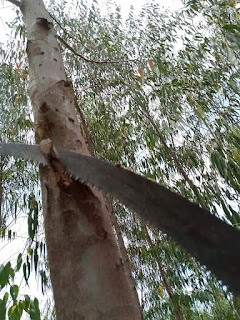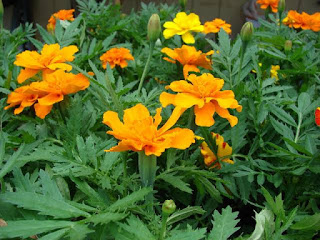It is evening and as Covid-19 has conditioned every Tom, Dick and Harry, I am coiled under the comfort of my abode. The phone beeps and the number displayed on the phone screen starts with a strange code. I pick up. It's Omino.
His booming sound echoes from the other side.
"Hey, Salim, good evening."
" Good evening, Omino, long time."
" Yeah yeah, long time. How is home?"
" Very fine, buddy." "How's there?"
" It's just Corona, nothing much" "Well, could we talk, now..or ? Some serious business stuff"
" Oh nice. No problem"
For those not in the know, Joel Omino is an environmental Conservation enthusiast and a tree-prenuer at that, hailing from the deep valleys of Lambwe, seated in Homabay County. Oscar Odhiambo and J. M Henga tell me they are his good neighbours.
I had not known him in person for 4 yrs, not until last year. This guy loves anything tree. I hear Omino can stand and mourn the death of one tree and literally reign terror in demanding the cause of death.
Controversially, he loves Eucalyptus more. Most people cringe when the name Eucalyptus leaves anybody's lips of late. Both laymen and professional in equal measure. You know why? See Take-a-ways below...
All said and done, Eucalypts beat other trees species in preference because of its availability of high quality planting materials, fast growth, ability to coppice,
ready market for its wide range of products and wide ecological range. In addition, the species supports rural livelihoods in terms of fuelwood, poles and building materials.
Omino: Salim given that God brought you home, i must be the first to tap the top layer. You remember my eucalyptus plantation?
Me: Yes I do. How are they doing?
Omino: They needy you. I need your vast forestry expertise here. You see, you have been away for so long. I got to make good use of you. I need you to advise me on my Eucalyptus management.
Me: ( chuckiling) At your service, Sir,
Early last year, we paid Omino a visit with my friend and Regreening Lambwe Initiative Co-Founder, Maxwell Ochoo. We were marvelled. You walk into his 3yr old plantation, sited next to his home in the "muddy Gamba" village, ( according to his wife, not my words), and you are greeted by a sight to behold. Very straight healthy Eucalyptus poles spanning the vast plantation with their leaves lively swaying to the evening breeze's force. He told us it runs into acres.
Omino: That is nice buddy. How much are we talking about here for your service?
Me: Well, professionally, i need to visit the plantation to give an informed case by case prescription of any silvi-cultural practice for each stand. However homogeneous a stand may be, there are still variations.
Omino: Wow. I love the approach. I am already learning some forestry vocs!
Me: Yeah, sure. Pay for classes already, hehe.
Omino: Well, when can you go? I have another one next to Ruma National Park. One year old. You must visit that too.
His other new farm has preparation going on in earnest, the seedlings are ready for transplanting, This farm, he says, will be called COVID-19 FARM. This he says believing that if we do not perish in this pandemic, we cannot look back and wish we worked the farms in 2020.
Me: As I am working from home, i am also gardening, lemi check my diary. And Joel, my charge will be based on the following deliverables;
Advice on:
1. Species choice and site matching( now that you want to establish another plantation.)
2. Ecological requirements
3. Management objectives( per species)
4. Site preparation
5. Transplanting/Planting
6. Tending
7. Pruning
8. Thinning
9. Pest and diseases control( for older stands mostly)
Omino: Salim, do a good job n i won't hesitate to recommend you for many referals.
Me: Deal Omino, remember eucalypts are self-pruning, but pruned to half heights only if necessary.
1. Professional Consultation is Key. In any project you MUST budget for consultation if you want to succeed. To realize good returns from a forestry investment/project, always consult people who are practically skilled in such. That is where WE , Foresters, come in.
2. Not all Eucalyptus trees are bad. They only need to be matched to a site( provenance matching)
3. Plant eucalypts in places receiving enough rainfall(mostly swampy, away from water sources) and for correct rotation period.
4. Eucalyptus grow very fast hence need more water for more carbon stock, but its cumulative water consumption in a rotation is far less than other species, less than a banana plant. Research by KEFRI, link
download the document here,
5. Your production objective informs the espacement, how far a tree will be from the other.
6. Pruning is selective. Only if necessary. Mostly for sawn timber and pulp to reduce knots. Prune only promising trees.You look to remove double leaders( double stems), branches competing with the main stem(lateral leader), and too much
branching within a small stem length
7. Thinning is done to give promising trees good room to grow in height and girth( diameter); Poorly formed trees are to be removed, but in stages. Thinned product can be sold as withies/ poles.
Samora Salim, is a Forestry and Agroforestry professional who has worked with various renowned conservation organizations in Kenya; equiped with unique vast practical experience and skills in forest management and agroforestry. Will be glad to serve you.



































